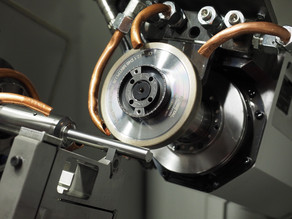Prototypical development of a sensory tool holder for in-situ process monitoring for high-speed internal cylindrical grinding (Projectnumber: KK 5072208 PK0)
The use of sensor-based tool holders for process analysis and especially for process monitoring in the manufacturing processes of milling, drilling and turning has established itself in recent years as the most powerful measuring strategy. By measuring the process forces as well as the disturbance variables influencing them in the tool holder as the non-wearing component closest to the process, a maximum resolution can be achieved. However, this requires that the sensors and microelectronics integrated in the holder can resist the high loads. For processes with geometrically undefined cutting edges, such as internal peel grinding, sensory tool holders are currently not available. For this process in particular, there is enormous potential for increasing performance and process stability through the use of suitable process monitoring with the assistance of in-process measurement technology.
Internal cylindrical grinding is an established manufacturing process for bore machining of hardened steels for the production of bearing and gear components. However, the engagement conditions are complex and the tools are very compliant during internal machining due to the slim, cantilevered tool body. These aspects represent a major challenge in process control. As a result, dimensional and shape deviations often occur in the workpiece, leading to rejects or demanding remachining. Increasing process monitoring is considered a necessary basis for reducing manufacturing deviations in the future with the use of suitable compensation strategies. However, there is currently no suitable, industrially applicable measuring technology on the market that is suitable for internal grinding processes under high speed conditions.
The aim of this project is to develop a sensory high-speed tool holder that enables process monitoring of internal grinding under high-speed and high-performance conditions. Through the combination of process know-how and innovative measurement technology, a production technology is to be raised to a new performance class, which is characterised by increased efficiency in the form of reduced process times and thus by considerable cost and energy savings. Measurement technology, used as an analysis tool in process development and also in industrial process set-up, but especially in real-time monitoring during the process, is a way to achieving the necessary performance ranges in the form of high material removal rates and product quality at the same time.




![[Translate to English:] [Translate to English:]](/storages/isf-mb/_processed_/4/8/csm_Schleifscheiben_8bb5d31229.jpg)